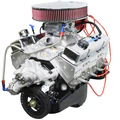The GM Small Block 350ci Engine, also known as the GM Small Block 350ci Engin, is one of the most iconic and widely used V8 engines in automotive history. Here’s an overview of its key features, history, and applications:
Engine Basics
-
Displacement: 350 cubic inches (5.7 liters)
-
Configuration: 90° V8
-
Block Material: Cast iron (aluminum versions also exist)
-
Bore x Stroke: 4.00″ x 3.48″
-
Firing Order: 1-8-4-3-6-5-7-2
-
Valvetrain: Overhead valve (OHV) with 2 valves per cylinder (pushrod design)
-
Fuel Type: Gasoline (carbureted and later fuel-injected versions)
-
Power Output: Typically ranged from 145–370+ horsepower, depending on year and configuration
History
-
Introduced: 1967 (as a larger displacement version of the original 265 ci small-block from 1955)
-
Produced Until: Factory production through the 2000s; crate engine versions still available
-
Legacy: Part of Chevrolet’s small-block family, it became the gold standard for American V8 performance and durability.
Applications on GM Small Block 350ci Engine
Used across a broad range of GM vehicles, including:
Cars
-
Chevrolet Camaro
-
Chevrolet Corvette (C3 and C4)
-
Chevrolet Impala
-
Chevrolet Chevelle
-
Chevrolet Nova
Trucks & SUVs
-
Chevrolet C/K pickups
-
Chevrolet Suburban
-
Chevrolet Blazer
Marine & Industrial Uses
-
Common in boats, hot rods, and aftermarket custom builds
Variants
-
L48 – Standard in many passenger cars
-
LT-1 – High-performance version (1970s)
-
L82 – Corvette and Camaro performance engine
-
ZZ4 / ZZ6 – Performance crate engines
-
Vortec 5700 (L31) – Final production version with modernized heads and fuel injection
Why It’s Popular
-
Parts Availability: Incredibly easy to find and cheap to build
-
Aftermarket Support: Massive—intake manifolds, camshafts, heads, stroker kits, etc.
-
Ease of Maintenance: Simple design with proven reliability
-
Swap Friendly: Common engine for hot rod and restomod projects
Detailed Technical Specs (Base 350)


